Pancho Does Not Smile For Christmas
Sunday, December 20, 2009
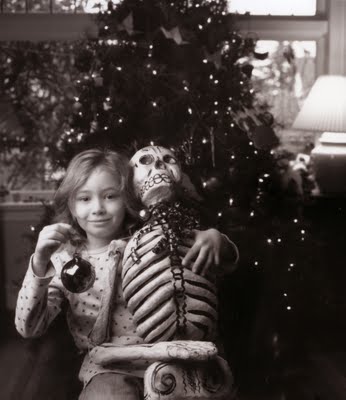 Sunday was really the first day of our Christmas holiday. Rosemary and I lingered in bed reading the Sunday New York Times and after feeding the cats, they came back and we stayed in bed. I continued reading Barbara Cleverly’s (no relation to Penelope Lively) The Last Kashmiri Rose which is a novel that is part of her series set in 1920s British Imperial India and features a Scotland Yard investigator and Flander’s Field veteran, Inspector Joe Sandilands. I was hooked when my neighbour Patricia Hutter lent me The Damascene Blade. Staying in bed to read without feeling guilty and keeping our financial worries buried (just a bit) is what Christmas is all about. The two girls arrived in the morning to find the Douglas Fir tree I had purchased earlier. Rosemary strung up the lights and Lauren and Rebecca did the decorations. My not so subtle cultural “indoctrination” was not to be interrupted by the holidays so I put on a CD of Lotte Lenya singing Kurt Veil’s The Seven Deadly Sins and Berlin Theatre Songs. Rebecca found her odd and after looking at her picture said she was ugly. But I think she began to tolerate the voice. The important factor is that she has been exposed. As contrast I put on my CD of J.J. Johnson and Andre Previn playing the music of Kurt Weil. Our friend Paul Leisz gave us a turkey for Christmas but Rebecca insisted in cooking it herself at home yesterday. We had a sumptuous pre-Christmas dinner at Rebecca’s (and Lauren’s, Hilary’s and Bruce’s) last night. For me it was a special pleasure (and a bit of a relief) to not have to cook or wash the dishes. Everybody was there including Rebecca and Lauren’s other grandparents. We left early in the evening and I got into bet to continue with The First Kashmiri Rose. What to post for yesterday’s blog? I came up with the idea of showing our tree (if only in b+w) so I took a Fuji instant print of Lauren with Pancho, who was given to us by Abraham Rogatnick last year. We will miss him for Christmas Eve. Lauren said to Pancho, “Please don’t smile.” Pancho, much in character, obeyed her.
Rebecca In Red - Revisited
Saturday, December 19, 2009
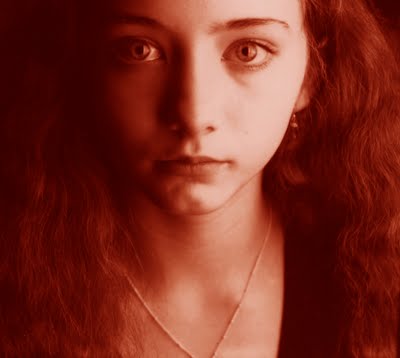 If there is anything that I have been doing with some sort of continuity this almsot past year, it is my informal study on how people look at images now that the internet is such a big player. I don’t think that much hullaballoo would result now if Vanity Fair were to put a nude pregnant actress, body painted) in a handbra pose on its cover. Demi Moore’s picture by Annie Leibovitz in August 1991 happened in a digitally unawakened era. Vanity Fair would have to up the ante by placing Elin Nordgren in a similar pose but with the banner, “Tiger is not ever going to hold this baby in his arms.” My photograph of Rebecca which I took sometime in August 1995 caused a bit of stir when I had it up at one-person show at a gallery at the end of that year. The very large giclée (a well made inkjet print on very good artist's paper) was purchased by local photography collector and philanthropist Yosef Wosk. People kept asking me, “Why would anybody want to buy a large photograph of your granddaughter?” My answer was the one given to me by Wosk himself which I remember as, “Alex I was unsettled by your granddaughter’s mystical expression.” 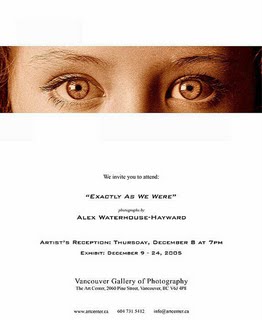 As I look at it now I can see that if I posted it here and mentioned I took it yesterday I could be accused of some sort sexually unethical behaviour on my part. The internet was not as prevalent in 2005 as it is now and the web youth and child exploitation police were in their infancy. They would perhaps object to two little flowered straps on her shoulders. They would object to the not neutral red tinting. Yesterday I took 20 eposures of Rebecca sitting at the chair by my computer. She objected and put a condition, “I will pose if you will play Risk with me.” I hate playing board games but I thought that my “sacrifice” was worth it if I got Rebecca’s cooperation. 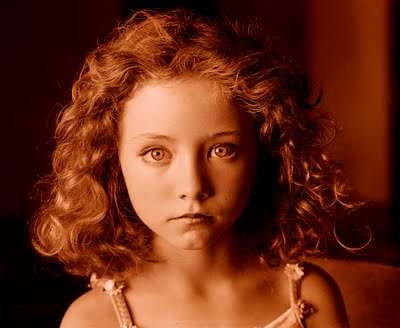 The picture you see here (at the very top) is the Fuji, b+w instant print that I took before I resorted to “real film” (as Rebecca calls film!). I scanned today Sunday and as I studied it (and particularly when I tinted it red) I realized I had a close facsimile of my iconic portrait of 2005. But I did it one better. This version (my mouth salivates as to what must be in the can or as latent images in that roll of 220 Kodak Plus-X) does not have the straps and is much tighter. By cropping in I have eliminated part of Rebecca’s beautiful charm which is her glorious hair. This picture is a safe version of the one from 2005 and will not cause stir with anybody I know. She now looks more ageless than ever before. Is she 6, 10, 12, 20 or even older? Oh how photography can lie while it reveals!
Twitterizing Time
Friday, December 18, 2009
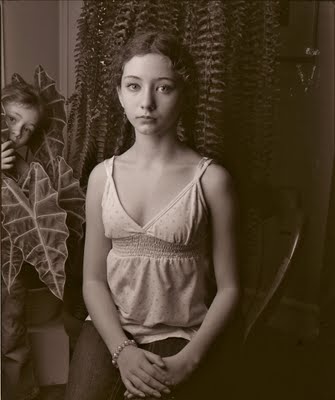 Twitterize –verb (used with object), -ized, -izing. 1. The act of enabling a person/object to access Twitter. 2. To show a person the wonders of Twitter. high school kid - hey, are you twitterized yet? college dude - Dude, I'm totally going to twitterize Shelly from Calculus tonight. Business person - Hey, are you twitterized yet? Now that I no longer have that magical gray wall of my studio as a background I must adapt and content myself with taking pictures of Lauren and Rebecca at our home. I have found a few sweet spots inside when it is raining outside and much too cold to take portraits in the garden. One of the sweetest is next to the Boston fern in our dining room. There is nice window lighting coming from the front garden but in all the pictures you see here I ignored it and used my trademark 2x3 ft soft box with one Dynalite flash head shooting through it. Usually, my light is at 45 degrees to my camera. I then raise the light and point it down 45 degrees. This light setup was pioneered by Bert Stern for Cosmopolitan and many call it cleavage lighting! The double 45 degree light will most often create an upside-down triangle on the darker side of the face. Coming from one side, the light mimics the window light I so often ignore. 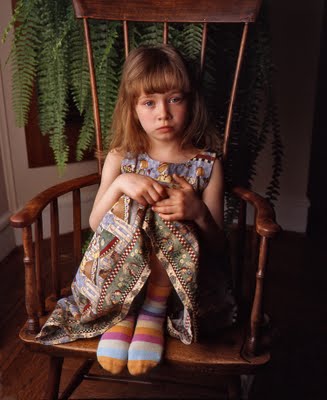 At this point I would like to coin a new word. The new word, twitterize, already exists with another meaning. See above. I am going to "Alice" it to my own purpose. My meaning has all to do with the shortening of everything because of our brief attention spans and our reduced time for leisure. We were supposed to have more time, and essays 20 years ago planted the pleasant problem of what we were going to do with all that leisure time we would have in our hands once automation came to our rescue. Those essays never predicted the modern smart phone, texting, Twitter, Facebook and wanting to read a magazine like Sports Illustrated in a special format apped (a verb much in use now!) to our smart phone. We had not yet invented the concept of multitasking.  Our world is getting twitterized. This means that most of what we do has to be done in a reduced period of time. This approach, in which even messages in Facebook, are getting to resemble Twitter in that they are becoming more and more compact, has especially affected photography. The modern DSLR or its poor cousin, the point and shoot digital camera enables photographers to take pictures anywhere under any lighting conditions. When those conditions get grim the little pop-up flash (or the built-in one) takes over. The overall result is a portrait in which the central flash produces no shadows on the face. It flattens that sense of three dimensionality that a light on one side will create. This side light was a light the the Flemish and Dutch painters mastered. This kind of picture, the one taken with that little central flash (photograph for me would be too kind a word so I will settle on picture), when reinforced by a forced or crazy smile, is what people expect and see now. 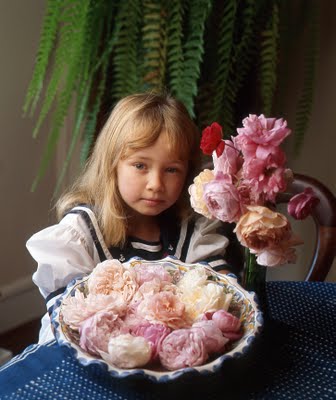 Some of the newer cameras even have (I kid you not!) a built-in smile sensor so that the camera will take that snap when the smile is at its apotheosis. These modern cameras are really no different from the older professional cameras that had attached motor drives. Film was expensive but we used to say, “Film is the cheapest part of photography so shoot!” But with the advent of digital cameras shooting lots is truly cheap and most attractive. So people shoot lots in less time. The idea of placing a big camera in front of Rebecca or Lauren and attaching it to a heavy tripod, takes time. The idea of setting up a light and placing inside a soft box, takes time. The idea of measuring the light (once it has been positioned to Bert Stern’s specifications) with a good flashmeter, takes time. Talking to one’s subject and making them look into the lens and respond to one’s instructions, takes time.  Taking four or five pictures, doesn’t take time. But all the time that preceded the pressing of the shutter will result in a few striking (simply because they are not the norm) portraits that fewer photographers are taking now as a memory for how portraits were once taken and lit begins to fade in our age of twitterized time. And of course I caught on to the Flemish and the Dutch many years ago. My Lauren and Rebecca rarely smile.
Between Child & Woman
Thursday, December 17, 2009
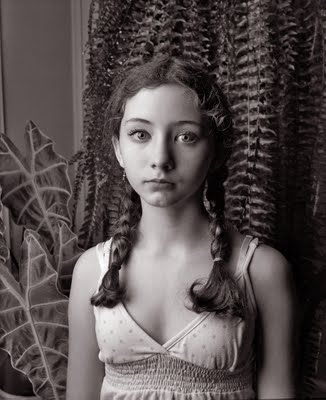
In the summer of 1994 Celia Duthie asked me to review a photography book for her beautiful little review magazine, The Reader. The book was a book that had caused some controversy in the US. It was Sally Mann’s Immediate Family. That book has been in my mind since and more so recently. The colour pictures you see here I took of Hilary (Rebecca’s mother) in the 70s, at Queen Elizabeth Park when she was 5. When she was 13 and her older sister 16 I had local art photographer James La Bounty photograph them. “Why would you do that?” many of my friends asked. “You are a good photographer. Why don’t you photograph them yourself?” My answer was always, “I see them as little girls because I am their father. James will see them, perhaps, as women.” But even then I wasn’t taking photographs of them as I do now of Rebecca. I cannot explain that I may have more fascination for a granddaughter, perhaps because she is that bit more detached from me than my daughters were. Or I could be a better photographer now so the portraits go more to the core of who Rebecca is. Or it could be a combination of that and the fact that Rebecca puts out a face to the world that is impossible not to notice.
Here is what I wrote:
Immediate Family by Sally Mann
Aperture, New York, $34.95
Photographers don’t always talk technical. Was it F-5.6? Was the film dunked in dilution B? They often discuss the last good photograph they took or a photography book that wrenched them out of a long photographer’s block. Few of the many released photo books have this kind of visual power. I ran into photographer Fred Herzog in Kitsilano recently. He complained to me: “The problem with the Vancouver Public Library is that most of their photography books are by John Hedgecoe.” This prolific English photographer of countless how-to books is photography’s answer to Barry Manilow.
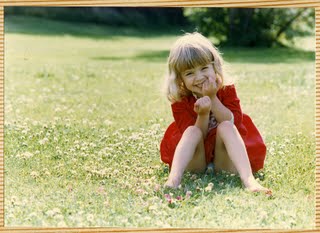
Photography books are not a recent phenomenon, although Richard Avedon’s plan to publish 10 in the next little while might be pushing the dreaded photographer’s bet-noir – overexposure. Good photo books have been around since Henry Fox Talbot published his Pencil of Nature in 1844. Because halftone reproduction of photographs in books had not been invented yet, Talbot personally hand-pasted his Talbotypes into every book. If you can find one of these it’ll cost you upwards of $250,000. At $90 a copy, George Hurrell’s Hollywood is a bargain.
Style is a rare commodity. Two English photographers of the 19th century, Calcutta-born Julia Margaret Cameron (the Annie Leibovitz of her time) and Charles Dodgson (Lewis Carroll) had style. Both photographed Alice Liddell (the original Alice) and both would have spotted her likeness in the pages of Sally Mann’s Immediate Family.
Between 1985 and 1990, American photographer Sally Mann photographed her three children, son Emmett and daughters Jessie and Virginia, at home in the nearby foothills of the Blue Ridge Mountains. The black and white photographs were all crisply taken with an 8x10 camera, a big and cumbersome item of equipment that Dodgson or Cameron would instantly have been comfortable with. The photographs are pastoral, funny and sad. Some are disturbing. In 1994 it is difficult to look at pictures of near-naked or naked little boys and girls without feeling slightly uncomfortable, even after knowing that these are artfully crafted family photographs taken by their mother. Few, if any, of these photographs would look like traditional family pictures even if they were photocornered onto a black paged album, dates and names in white ink. Perhaps what novelist Ann Beattie said n Mann’s earlier book, At Twelve: Protraits of Young Women, applies: “These girls still exist in an innocent world in which a pose is only a pose – what adults make of that pose may be the issue.”
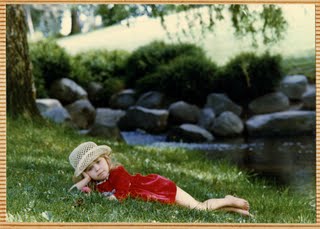

A paradox of parenthood is that while we parents might boast about how our one-year-old son can walk and talk, we are usually the last to notice when our children cease to be children. French Jesuit Pierre Teilhard de Chardin likened the slow upward journey of primeval slime towards life to ever-diminishing, circular planes from a sliced cone. In many of the photographs, but particularly in Candy Cigarette, 1989 (below), Jessie beckons like Helen for her Paris. She could be on either side of that threshold – Teilhard’s point – between child and woman. She seems to be undecided. But for the moment, captured by Mann’s magic lens, Charles Dogson wrote in Through the Looking Glass:
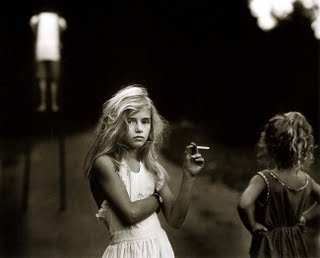
In a Wonderland they lie,
Dreaming as the days go by,
Dreaming as the summers die…
Wednesday, December 16, 2009
 “Were we made for this” December 16, 2009 Alex kindly invited me to provide a piece as a guest on his blog having looked at a recently completed piece I did in reaction to the incredible amount of money being spent on the Vancouver 2010 Winter Olympics. I watched the raising of the city's first big corporate sponsored building advertisement, over the façade of the landmark Bay store, at the corner of Granville and Georgia. It wasn’t so much the shots of the Bay clad athletes (I applaud dedication and the spirit of the Olympians) that took my attention, but the marketing phrase “We were made for this”, then looked at all four corners of the intersection only to see the signs of Vancouver’s ongoing shame in the form of three regular and homeless individuals vying for their daily needs from passers-by and I truncated the marketing with “Were we made for this”, and the accompanying pictures of the homeless speaks for itself. We’ve all read in the local, national, and even international press about the ever increasing issue of homelessness in our city. We’ve heard our politicians talk the talk, but the problem seems to increase each year with little political will to create a climate of caring and more importantly change for those less fortunate in our society, the homeless. The facts “Greater Vancouver’s homeless crisis continues to grow at a “stunning” and “shocking” rate, with a 373-per-cent increase in street homelessness since 2002”, a story in The Vancouver Province, September 17, 2008, demonstrating the reckless disregard and neglect of a long standing issue in our city, and yet, we can spend (and ESTIMATED as we speak) $600 million dollars on this 4 week corporate event for a privileged few to travel on a road going nowhere for the average BC resident, legacy projects that serve an elite and small group of Vancouver citizens and the promise this will boost investment and tourists to our fine city, province and country. We are told, or it is implied, we should perhaps stay away during the event, and watch the mushrooming over the wall security network, being paid by you and I, push the likely cost of these games to over $600 million. Ian Bateson, Creative Director Baseline Type & Graphics
A Photographic Relationship
Tuesday, December 15, 2009
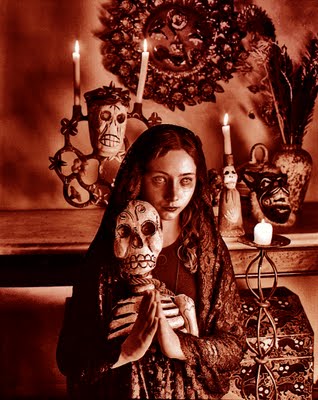
I tell my photography class students that they must cultivate a photographic relationship with the people they photograph. I don’t like to use the term model and so opt for the less deprecatory subject. Paradoxically, while model brings to mind a human being that we treat as an object (if we are rude and do not know any better) a subject (which could be an animal or even a theme or thing) seems to be more human. For me when I call my models subjects I want to put forward the idea that a human being stands or sits in front of me and there is a mutual interaction which I hope is a pleasant or at least a tolerable one.
The photographic relationship involves taking pictures more than once. At Focal Point I have an average of 8 or 9 students per class and when we have a shooting day (3 hours) we have two subjects in two adjoining studios. My students shoot like mad trying to get everything they can in those three hours. They must face having a good idea that is then copied by a fellow student that is watching. Sometimes the copy is better than the original. I tell them this is the way it is (to learn under adversity) until they get enough nerve to find a subject they find interesting and then dedicate multiple private sessions with them in which that photographic relationship grows to the point that in some cases verbal communication is not necessary.
I photographed Tarren for something like 25 years until she tired of it. But I have Yuliya and the Thursday girl, Jo-Ann who usually poses for me on Thursdays about four times a year. Our sessions will have to shift to my living room now that my studio is no more. I enjoy looking at the big fat files that are dated for each session so I can observe the progression of change and age.
By the above standards, one of the best subjects I have ever had is my 12 year-old granddaughter Rebecca. I have been giving a lot of thought to the nature of my pictures as she gets older and I will probably elaborate on this later on in the week or month.
More often than not she faces my camera cheerfully after some initial protestation. Here you see her as I photographed her last Halloween in my dining room with Abraham’s Mexican skeleton. This is one of those unintended double exposures or perhaps the long shutter caught her eye movement. Rebecca looks spooky. Spooky in this day and age is a safe mode. And I wonder just why.
At one time I am sure some ultra conservative Catholic Spaniard from my grandmother’s side of the family would have protested at the religious travesty of the theme. My grandmother would have smiled and simply said, “Nobody understands artists. Alex and I are both artists.” She would have winked a conspiratorial eye at me and I would have known that everything was all right.
Seduced By Rosemary - A Hilarious Consequence
Monday, December 14, 2009
 37 years and about nine months ago Rosemary arrived at the Mexico City airport from visiting her parents in Ottawa. She was radiant in a beautiful, very tight and very short orange mini dress. We went home and she seduced me. I never did ask. I suspect that her parents might have recommended that a second child might help iron out whatever difficulties Rosemary might have with her Latin husband. I remember that night. Hilary was 37 today. It seems only yesterday that Hilary was a few weeks old and my mother said, “She has beautiful hands.” And it seems it was only yesterday that she was 4 or 5 and we were in the posh dining room of the St. Francis Hotel in San Francisco and Hilary was crying loudly (below, right) and having a berrinche (a Mexican tantrum). The beautifully dressed waiter came up to me and said, “Sir is there anything we can do for the young lady?” I was too stupid to understand that he wanted to help so I answered, rudely, “If you can find her some beans and tortillas that will make her stop.” 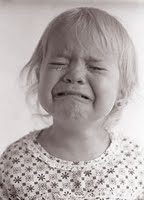 She is 37 today and when I gaze at her I gaze at the face of my mother. She has her ways, especially her patience to deal with her two, sometimes difficult little girls. Bruce and Hilary arrived at 6. We prepared a cheese fondue and Rebecca had made a delicious chocolate cake from scratch. Bruce and I indulged in a bottle of Argentine Torrontés white wine. We were all at the table and I cannot think of anything better except perhaps our Christmas Eve dinner to come. 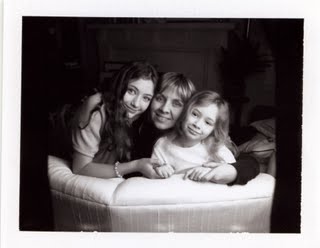 After dinner I took two Fuji instant pictures of the three girls. In the first they smiled, that kept them happy, in the second they didn’t and that made me happy. Rosemary and I are so lucky.
|

























